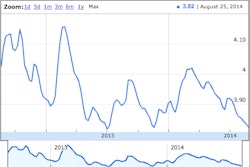The Technology & Maintenance Council (TMC) held an informational technical session at its Fall Meeting Tuesday to identify a driveline failure trend seen in the industry today.
With representatives on hand from Detroit Diesel, Dana and Meritor, the Council showed how engines today operating at lower RPMs (as a result of EPA 2010 regulations) have forced changes to axle ratios and created higher levels of torque. While these changes have succeeded at achieving more fuel efficiency, the TMC panel says the additional torque created, and how it is transferred, has dramatically increased the number of driveline component failures.
Dana’s Don Remboski says the issue stems from the RPM change. Running an engine at lower RPMs creates a more efficient, smoother engine, but it also requires adjusted axle ratios and torque to maintain speed and performance levels in the driveline.
These higher torque levels are particularly visible, and dangerous, during start and stop applications. And because the industry adopted this technology for 2010 regulations — and not when it was perfected — there have been challenges.
“We are evolving a little more rapidly than is comfortable right now,” Remboski says.
The panel says fleets have multiple solutions to minimize these failures.
Meritor’s Bob Ostrander says updating engine software can quell some failures by preventing torque levels from reaching damaging heights. Meritor research shows that nearly all torque/driveline related failures occur within seconds of a vehicle start or stop.
“Most of this is happening when trucks are still in the terminal,” he says.
Drivers willing to wait 2-3 seconds to engage the throttle after releasing the clutch also can nearly eliminate these failures, the group says.
Once a truck is in gear, it doesn’t need rapid acceleration to go, says Detroit Diesel’s Chuck Blake.
And Remboski adds that spec’ing remains extremely important.
“More iron” won’t eliminate the risk of a failure, says Ostrander, but it can reduce it.
For fleets with a high prevalence of driveline failures, there are more robust components available, and Remboski says spec’ing engines, transmissions and drivelines designed to work as a single unit will reduce fault risks.
“The components in the driveline are designed to work under certain circumstances,” he says. “We have application guidelines that are very detailed as to the application of a truck.”












